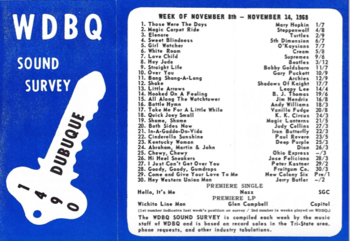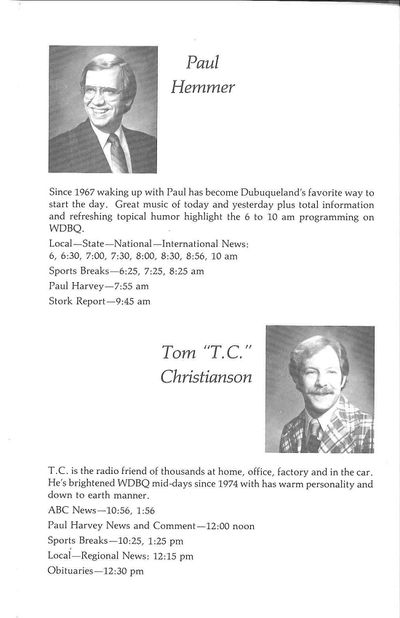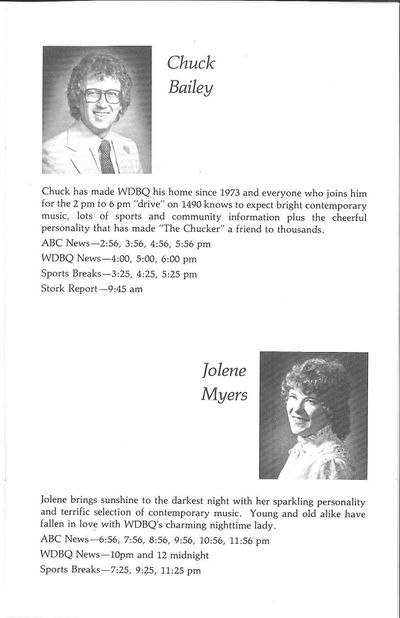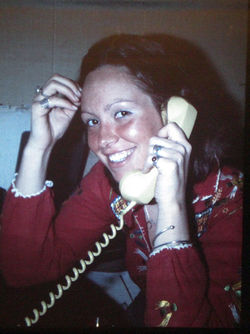Encyclopedia Dubuque
"Encyclopedia Dubuque is the online authority for all things Dubuque, written by the people who know the city best.”
Marshall Cohen—researcher and producer, CNN
Affiliated with the Local History Network of the State Historical Society of Iowa, and the Iowa Museum Association.
WDBQ: Difference between revisions
No edit summary |
No edit summary |
||
| (16 intermediate revisions by the same user not shown) | |||
| Line 1: | Line 1: | ||
WDBQ. We wish to thank [[HEMMER, Paul|Paul HEMMER]] for | [[Image:wdbqfirst.png|left|thumb|250px|WDBQ when it was located above First National Bank of Dubuque. Photo courtesy: Photo courtesy: https://www.facebook.com/pages/You-know-you-grew-up-in-Dubuque-Iowa-if-you-remember/130170407077838]] | ||
WDBQ. We wish to thank [[HEMMER, Paul|Paul HEMMER]] for these "treasures" of radio history. | |||
See: [[RADIO]] | |||
“'''Great WDBQ Record Drop'''” by Paul Hemmer | |||
[[File:schreefer1.JPG|250px|thumb|left|Dennis Shreefer]]Dennis Shreefer was a popular night time personality on WDBQ-AM from about 1966-1968. He played Top-40 hits, but also injected his rather controversial political views into the program - much to the consternation of the station's management. Whenever he get a "never do that again" he would behave for a few weeks and then launch into another political opinion that drove management crazy. However, he was VERY popular and he stayed. | |||
[[File:schree2.JPG|250px|thumb|left|"Teen Life Magazine"]] | |||
[[File:schree3.JPG|250px|thumb|left|]]His handsome good looks landed him on the front page of ''Teen Life Magazine'' with a feature story and as a contestant in their Most Handsome DJ contest. | |||
[[File:sh1.JPG|250px|thumb|left|Promotional activities of Hemmer and Shreefer]] | |||
[[File:sh2.JPG|250px|thumb|right|Famous hair cutting episode.]]When Paul Hemmer began his popular morning show, he and Dennis would often do cross-promotions. One involved Dennis' Beatle haircut. It culminated in Paul using a hedge shears to cut a chunk of Denny's hair in front of a large audience in the 8th & Main window of [[MONTGOMERY WARD]]. | |||
The WDBQ studios were located on the “9th floor of the beautiful [[FISCHER BUILDING]] at 9th and Main, downtown Dubuque.” One evening in the summer of 1967 the rooftop of the building provided Denny Schreefer’s listeners with the one and only “Great WDBQ Record Drop.” The elevator room next to the rooftop door was where the station kept boxes of rejected records sent by the major and minor labels. These arrived by the dozens every day. At most stations, a music director would carefully go through the new arrivals and select the best for airplay consideration, but not WDBQ in 1967. Denny did most of the “selecting” based on his personal preferences and then just dumped what he did not personally like into a cardboard box that went to the elevator room. | |||
On a warm June evening in ’67 the idea of the “Great WDBQ Record Drop” was born. Shreefer and Hemmer assembled packs of 5 records wrapped with a rubber band. At least one of the 5 discs was a legitimate "hit." The others were wasted vinyl. | |||
Around 8:00 p.m. Denny announced to his large teenage audience that right after the 8:55 p.m. network news he wanted everyone listening to assemble in the alley between Main and Locust for a chance to win packs of 5 "45s" that we would toss to them in the first “Great WDBQ Record Drop.” By 9:00 p.m. the alley was packed with teens looking skyward and waiting for the action. At 9:00 p.m. Hemmer and Shreefer started dropping 5 packs of 45s on the crowd below. | |||
Within minutes two or three police cars raced to the scene and an officer with gun drawn yelled for us to “Stop immediately!” Suddenly the stupidity of that instant promotional idea sank in. An officer arrived on the rooftop a few minutes later and asked a lot of questions. The next day came a rather stern lecture from station management on “liability” and instructions that there would be no more spontaneous promotions in the future. | |||
Later that year Shreefer & Hemmer came up with another promotional idea that was met with management approval: a pageant that told the story of our river town from the earliest days. An outline was created, and Hemmer started writing songs for a show that they hoped the radio station would back-- “Child of the River.” | |||
Shreefer & Hemmer met at the public library with Harry Schichter, [[MERCER, Helen|Helen MERCER]], [[NORMAN, Wayne Andrew Sr.|Wayne Andrew NORMAN, Sr.]] and others from the [[DUBUQUE COUNTY HISTORICAL SOCIETY]] to present the idea. The Historical Society loved it, but had no money to support the idea. WDBQ ownership liked the concept and gave the nod to proceed – and worry about the money after the show was written. Unfortunately it was never completed. Denny had been quietly sending out audition tapes to other radio stations and was finally accepted by a suburban Detroit FM station. The dream of a musical pageant died with his exit from WDBQ. | |||
That meeting with the Historical Society remained in Wayne Norman’s fertile mind and resurfaced when he called upon Hemmer to co-author a show Norman named [[GET THE LEAD OUT]] in 1965. The song “Child of the River” soon became “The Lazy Mississippi” and the melody of “Floatin’ Gold” became “You Can’t Cheat an Honest Man.” Both were well received when “GTLO” debuted at the [[FIVE FLAGS CIVIC CENTER]] in the summer of 1976. | |||
[[File:wdbqss.png|350px|thumb|left|]] | |||
[[File:WDBQA1.jpg|700px|thumb|left|]] | [[File:WDBQA1.jpg|700px|thumb|left|]] | ||
[[File:WDBQB.jpg|700px|thumb|left|]] | [[File:WDBQB.jpg|700px|thumb|left|]] | ||
| Line 20: | Line 48: | ||
[[File:airwaves-page b.JPG|400px|thumb|left|Airwaves]] | [[File:airwaves-page b.JPG|400px|thumb|left|Airwaves]] | ||
[[File:WDBQ-A.JPG|400px|thumb|left|Meet Your Friends at WDBQ. Images courtesy: Paul Hemmer]] | |||
[[File:WDBQ-A.JPG|400px|thumb|left|]] | [[File:WDBQ-B.JPG|400px|thumb|left|Meet Your Friends at WDBQ. Images courtesy: Paul Hemmer]] | ||
[[File:WDBQ-B.JPG|400px|thumb|left|]] | [[File:WDBQ-C.JPG|400px|thumb|left|Meet Your Friends at WDBQ. Images courtesy: Paul Hemmer]] | ||
[[File:WDBQ-C.JPG|400px|thumb|left|]] | [[File:WDBQ-D.JPG|400px|thumb|left|Meet Your Friends at WDBQ. Images courtesy: Paul Hemmer]] | ||
[[File:WDBQ-D.JPG|400px|thumb|left|]] | [[File:WDBQ-E.JPG|400px|thumb|left|Meet Your Friends at WDBQ. Images courtesy: Paul Hemmer]] | ||
[[File:WDBQ-E.JPG|400px|thumb|left|]] | [[File:WDBQ-F.JPG|400px|thumb|left|Meet Your Friends at WDBQ. Images courtesy: Paul Hemmer]] | ||
[[File:WDBQ-F.JPG|400px|thumb|left|]] | [[File:WDBQ-G.JPG|400px|thumb|left|Meet Your Friends at WDBQ. Images courtesy: Paul Hemmer]] | ||
[[File:WDBQ-G.JPG|400px|thumb|left|]] | |||
| Line 40: | Line 64: | ||
[[File:p6.jpg|250px|thumb|right|Nadine Marchesi, very popular KIWI evening host who went from Dubuque to KMEL in San Francisco. Image courtesy: Paul Hemmer]] | [[File:p6.jpg|250px|thumb|right|Nadine Marchesi, very popular KIWI evening host who went from Dubuque to KMEL in San Francisco. Image courtesy: Paul Hemmer]] | ||
[[File:p7.jpg|250px|thumb|left|Paul Hemmer, foreground, with Tom Berryman doing the morning show in the 11th and Iowa studios]] | [[File:p7.jpg|250px|thumb|left|Paul Hemmer, foreground, with Tom Berryman doing the morning show in the 11th and Iowa studios]] | ||
[[File:p8.jpg|250px|thumb|right|Tom | [[File:p8.jpg|250px|thumb|right|Tom Oglesby, one of Dubuque's finest radio voices. Image courtesy: Paul Hemmer]] | ||
[[File:p11.jpg|left|thumb|250px|Ron Berkenholtz in the WDBQ news booth. Photo courtesy: Paul Hemmer]] | [[File:p11.jpg|left|thumb|250px|Ron Berkenholtz in the WDBQ news booth. Photo courtesy: Paul Hemmer]] | ||
[[File:p13.jpg|right|thumb|250px|Al Skinner, chief engineer, at the WDBQ/KLYV transmitter site. Al Skinner is related to Paul Skinner who was the original program director at WKBB-AM in Dubuque in 1933. Photo courtesy: Paul Hemmer]] | [[File:p13.jpg|right|thumb|250px|Al Skinner, chief engineer, at the WDBQ/KLYV transmitter site. Al Skinner is related to Paul Skinner who was the original program director at WKBB-AM in Dubuque in 1933. Photo courtesy: Paul Hemmer]] | ||
| Line 48: | Line 72: | ||
[[Category: Broadcasting Companies]] | [[Category: Broadcasting Companies]] | ||
Latest revision as of 14:05, 12 February 2020

WDBQ. We wish to thank Paul HEMMER for these "treasures" of radio history. See: RADIO
“Great WDBQ Record Drop” by Paul Hemmer
Dennis Shreefer was a popular night time personality on WDBQ-AM from about 1966-1968. He played Top-40 hits, but also injected his rather controversial political views into the program - much to the consternation of the station's management. Whenever he get a "never do that again" he would behave for a few weeks and then launch into another political opinion that drove management crazy. However, he was VERY popular and he stayed.
His handsome good looks landed him on the front page of Teen Life Magazine with a feature story and as a contestant in their Most Handsome DJ contest.
When Paul Hemmer began his popular morning show, he and Dennis would often do cross-promotions. One involved Dennis' Beatle haircut. It culminated in Paul using a hedge shears to cut a chunk of Denny's hair in front of a large audience in the 8th & Main window of MONTGOMERY WARD.
The WDBQ studios were located on the “9th floor of the beautiful FISCHER BUILDING at 9th and Main, downtown Dubuque.” One evening in the summer of 1967 the rooftop of the building provided Denny Schreefer’s listeners with the one and only “Great WDBQ Record Drop.” The elevator room next to the rooftop door was where the station kept boxes of rejected records sent by the major and minor labels. These arrived by the dozens every day. At most stations, a music director would carefully go through the new arrivals and select the best for airplay consideration, but not WDBQ in 1967. Denny did most of the “selecting” based on his personal preferences and then just dumped what he did not personally like into a cardboard box that went to the elevator room.
On a warm June evening in ’67 the idea of the “Great WDBQ Record Drop” was born. Shreefer and Hemmer assembled packs of 5 records wrapped with a rubber band. At least one of the 5 discs was a legitimate "hit." The others were wasted vinyl.
Around 8:00 p.m. Denny announced to his large teenage audience that right after the 8:55 p.m. network news he wanted everyone listening to assemble in the alley between Main and Locust for a chance to win packs of 5 "45s" that we would toss to them in the first “Great WDBQ Record Drop.” By 9:00 p.m. the alley was packed with teens looking skyward and waiting for the action. At 9:00 p.m. Hemmer and Shreefer started dropping 5 packs of 45s on the crowd below.
Within minutes two or three police cars raced to the scene and an officer with gun drawn yelled for us to “Stop immediately!” Suddenly the stupidity of that instant promotional idea sank in. An officer arrived on the rooftop a few minutes later and asked a lot of questions. The next day came a rather stern lecture from station management on “liability” and instructions that there would be no more spontaneous promotions in the future.
Later that year Shreefer & Hemmer came up with another promotional idea that was met with management approval: a pageant that told the story of our river town from the earliest days. An outline was created, and Hemmer started writing songs for a show that they hoped the radio station would back-- “Child of the River.”
Shreefer & Hemmer met at the public library with Harry Schichter, Helen MERCER, Wayne Andrew NORMAN, Sr. and others from the DUBUQUE COUNTY HISTORICAL SOCIETY to present the idea. The Historical Society loved it, but had no money to support the idea. WDBQ ownership liked the concept and gave the nod to proceed – and worry about the money after the show was written. Unfortunately it was never completed. Denny had been quietly sending out audition tapes to other radio stations and was finally accepted by a suburban Detroit FM station. The dream of a musical pageant died with his exit from WDBQ.
That meeting with the Historical Society remained in Wayne Norman’s fertile mind and resurfaced when he called upon Hemmer to co-author a show Norman named GET THE LEAD OUT in 1965. The song “Child of the River” soon became “The Lazy Mississippi” and the melody of “Floatin’ Gold” became “You Can’t Cheat an Honest Man.” Both were well received when “GTLO” debuted at the FIVE FLAGS CIVIC CENTER in the summer of 1976.
Airwaves (WDBQ publication. Images courtesy: Paul Hemmer}












































